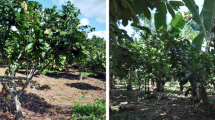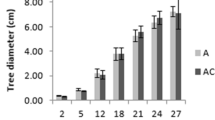Abstract
The cultural features, management practice, environmental sustainability, and economic profitability of smallholder cacao (Theobroma cacao)production in West and Central Africa are reviewed. The aim is tohighlight factors affecting the cacao production and marketing sectorand to propose appropriate strategies to ensure sustainable and profitable cacao production in the region. The cacao cultivation system causes minimum damage to soil resources. In terms of carbon sequestration and below- and above-ground bio-diversity, the cacao agroforest is superior to the alternative food crop production land use. The food crop production system is based on the practice of slash-and-burn farming, which, due to population pressure and reduced fallow cycle, is no longer sustainable. Economic profitability analysis of this system in Cameroon showed that, at current prices, even with no value assigned to the tree species, the sector could still be profitable. Based on the current review and our knowledge of West and Central Africa, there is an urgent need to: (a) rationalize and optimize arrangement of the various components in cacao agroforest, (b) domesticate high value and shade tolerant indigenous species such as Gnetum africanum and integrate into the system in order to enhance the system's diversity and profitability, (c) develop shade-tolerant and disease-resistant cacao varieties, (d) integrate small-stock production into the system, and (e) develop an enabling policy environment addressing cacao marketing, plant protection, land tenure and transformation of non-cacao primary products from the cacao agroforests.
Similar content being viewed by others
References
Amoah FM, Muertey BN, Baidoo-Addo, Oppong FK, Osein Bonsu K and Asamoah TEO (1995) Underplanting oil palm with cacao in Ghana. Agroforestry Systems 30: 289–299
Bakala J (1981) Repartition des types morphologiques de Phytophthora palmivora (Butl.) au Cameroon. Proceeding of the 7th International Cacao Research Conference, Douala Cameroon, 1979: 297–301
Bakala J and Kone S (1998) Lutte chimique la pourriture brune des Cabosses du Cacao: le forum R., un nouveau fungicide a 28 jours de fréquence de traitements, une grande première au Cameroun. Communication présentee lors du Séminaire international sur les maladies et les insectes nuisibles du Cacaoyer a Yamoussoukrou, Côte d'Ivoire, 19–24 janvier, 1998
Duguma B and Franzel S (1996) Landuse analysis and constraint identification with special reference to agroforestry. In: GFID and FAO (eds) International Seminar on Tools for Analysis and Evaluation of Sustainable Land Use in Rural Areas. 2–16 December, 1996. Zschortau, Germany, pp 1–16. German Foundation for International Development (GFID), Zschortau, Germany
Duguma B, Tonye J and Depommier D (1990) Diagnostic survey on local multipurpose tree/shrubs fallow systems, and livestock in southern Cameroon. ICRAF Working Paper No. 60, ICRAF, P.O. Box 30677, Nairobi, Kenya, 34 pp
Egbe NE and Adenikinju SA (1990) Effects of intercropping on potential yield of Cacao in south-western Nigeria. Café ‘Cacao Thé’ 34(4): 281–284
Entwistlle PF (1987) Insect and cacao, In: Wood GAR and Lass RA (eds) Cacao, pp 336–442
FAO (1997) State of the World's Forest. FAO, Rome, Italy, 200 pp
Fianu FK, Adde PC and Adjorlolo L (1994) Sheep rearing under tree crop plantation in Ghana's forest zone: problems and prospects. In: Lebbie SHB and Kagwini E (eds) Small Ruminant Research and Development in Africa, pp 87–91. International Livestock Research Institute (ILRI), Nairobi, Kenya
Gockowski J (1994) Supply responses among smallholder producers of arabica and robusta coffee in Cameroon. PhD thesis, University of Florida, Gainseville, USA
Gockowski J, Tonye J and Baker D (1997) Characterization and diagnosis of Agricultural system in the Alternatives to Slash-and-Burn forest margins benchmark of southern Cameroon: IITA-HFS, Yaounde, Cameroon, 68 pp
ICCO (International cacao organization) (1997) Quarterly Bulletin of CACAO Statistics, June, ICCO, London
ICRAF (1996) ICRAF Annual Report 1996, International Center for Research in Agroforestry, P.O. Box 30677, Nairobi, Kenya, 340 pp
ICRAF, CIRAD (Centre de Coopération International en Recherche Agronomique pour le Développement), FF (Ford Foundation) and ORSTOM (Institut Français de Recherche Scientific pour le Développement en Coopération) (1997) Agroforests: Creating Profitable and Sustainable Multipurpose Forest in the Agricultural Lands of the Humid Tropics, Examples from Indonesia. International Center for Research in Agroforestry, P.O. Box 30677, Nairobi, Kenya, 16 pp
IRAD (Institut de la Recherche Agricole pour le Développement) (1997) Progress report on slash-and burn agricultural research in Cameroon., Institut de la Recherche Agricole pour le Développement, P.O. Box 2067, Yaounde, Cameroon, 124 pp
Kotto-Same JPL, Woomer Moukam A and Zapfack L (1997) Carbon dynamics in slash-and burn agriculture and land use alternatives in the humid forest zone of Cameroon. Agriculture, Ecosystems and Environment 65(3): 245–256
Leakey RRB (1998). Agroforestry in the humid lowlands of west Africa. Some reflections on future directions for research. In: Duguma B (ed) Agroforestry Systems 40(3): 253–262
Leakey RRB and Izac A-M N (1996) Linkages between domestication and commercialization of non-timber forest products: Can farmers be the beneficiaries through Agroforestry? In: Leakey RRB, Temu AB, Melnyk M and Vantomme P (eds) Domestication and Commercialization of Non-timber Forest Products in Agroforestry Systems. Non-wood Forest Products #9, FAO, Rome, Italy
Losch B, Fusillier JL and Dupraz P (1990) Strategies des Production en Zone Cafiere et Cacaoyer du Sud Cameroun: Quelles adaptations a la crise? CIRAD, Département System Agraires, Montpellier
Mack SD (1989) Livestock in Plantation Systems. International Livestock Center for Africa, Humid Zone Programme, Ibadan, Nigeria, 60 pp
Maddison AC and Griffin MJ (1981) Detection and movement of inoculum. In: Gregory PH and Maddison AC (eds) Epidemiology of Phytophthora on Cacao in Nigeria. Phytopathological paper No. 25.Commonwealth Mycological Institute, Kew, England, pp 31–50 (quoted in Lass RA 1987)
Monke EA and Pearson SR (1989) The Policy Analysis Matrix for Agricultural Development. Cornell University Press, Ithaka, 279 pp
Nair PKR (1984) Soil Productivity Aspects of Agroforestry. Science and Practice of Agroforestry, International Center for Research in Agroforestry, P.O. Box 30677, Nairobi, Kenya, 85 pp
Okali DUU and Owusu JK (1975). Growth analysis and photosynthetic rates of Cacao (Theobroma cacao L.) seedlings in relation to varying shade and nutrient regimes. Ghana Journal of Agricultural Science 8: 51–67 (quoted in Wessel M 1987)
Okafor JC and Lamb A (1994) Fruit trees: diversity and conservation strategies. In: Leakey RRB and Newton AC (eds) Tropical Trees: the Potential for Domestication and the Rebuilding of Forest Resources, pp 34–41. HMSO, London
Padwick GW (1956) Losses caused by plant disease in the colonies. Phytopathological paper No. 1. Commonwealth Mycological Institute. Kew, England (quoted in Lass 1987)
Ramadasan K, Abdullah I, Teoh KC, Vanialigam T and Chan E (1978) Inter-cropping of coconuts with cacao in Malaysia. Magazine of the Incorporated Society of Planters 54(622): 329–342 (quoted in Amoah et al. 1995)
Sanchez PA and Salinas JG (1981) Low-input technology for managing Oxisols and Ultisols in tropical America. Adv Agron 34: 279–406
UNCTAD (United Nations Conference on Trade and Development) (1995) Handbook of International Trade and Development Statistics. Geneva, Switzerland
Wessel M (1987) Shade and nutrition. In: Wood GAR and Lass RA (eds) Cacao, pp 166–194
Rights and permissions
About this article
Cite this article
Duguma, B., Gockowski, J. & Bakala, J. Smallholder Cacao (Theobroma cacao Linn.) cultivation in agroforestry systems of West and Central Africa: challenges and opportunities. Agroforestry Systems 51, 177–188 (2001). https://doi.org/10.1023/A:1010747224249
Issue Date:
DOI: https://doi.org/10.1023/A:1010747224249




